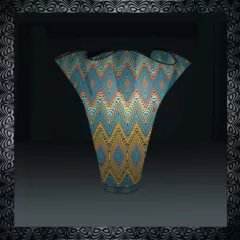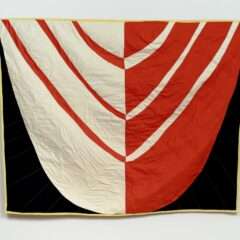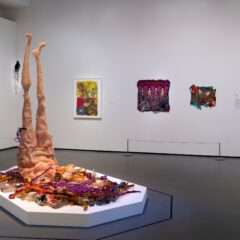Author’s introduction
I interviewed Margery Amdur, who has an extremely full and exciting schedule this Fall and Winter. Currently, Amdur is showing in The Unbearable Lightness of the Fantastical and Unwearable Art Show at the Drawing Room Gallery, Jersey City, NJ, through November 11, and in Fiber Reimagined, an exhibition in collaboration with Fiber Art Now Magazine, October 6 – November 12, 2023, at the Gravers Lane Gallery, Philadelphia.
The interview was conducted in the artist’s studio, followed up with Zoom, transcribed and edited for length and clarity. For additional opportunities to see the artist’s works and hear her talk about them this Fall and Winter, see the full list at the end.
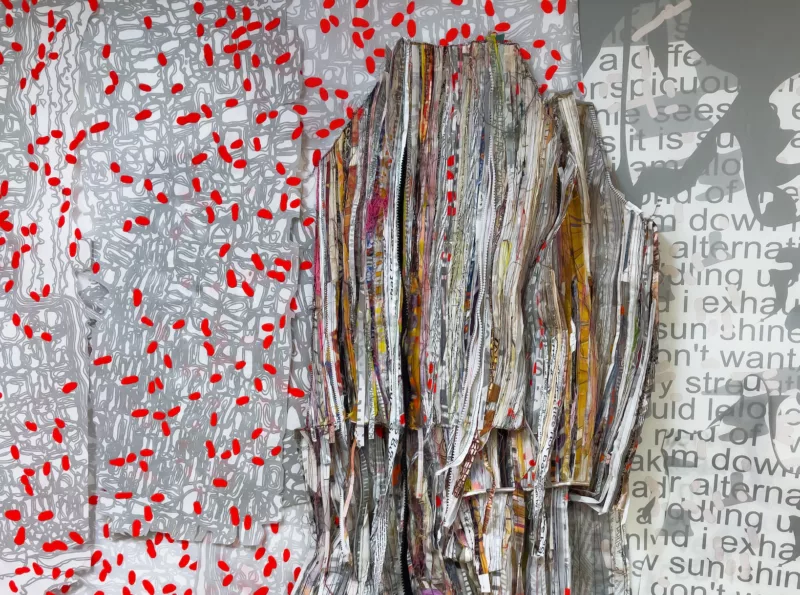
Susan Isaacs: You describe yourself as “a multidisciplinary installation artist who uses accumulation and repetition to explore tensions inherent in identity formation—standing out and blending in, nature and nurture, repair and rupture.” How did you arrive at this place? What area of study did you first undertake when you went to art school?
Margery Amdur: I received my BFA at Carnegie Mellon University, in Pittsburgh, PA in 1975. I thought “real” artists were either painters or sculptors. The other areas were secondary. So, I started off as a painting major, but a painting major who couldn’t keep her imagery within the confines of the picture plane and was unable to resolve a painting. It was never satisfactory. I switched my major to printmaking which required printing one color at a time. This way of working slowed me down and has profoundly affected my studio practice. Today, I build layers and accumulate images and forms.
In 1979, I went to the University of Wisconsin, Madison for graduate school. At that time Madison’s printmaking department was ranked number one in the country. However, when I arrived, students and faculty were working with a wide range of non-traditional art materials. It was as if I had been living under a rock! This was largely a result of my racing through high-school and college and entering graduate school at the age of 21. My exposure to more adventurous art making and formats was limited. I thought that my building an oversize silkscreen, requiring cleaning at a car wash, was radical.
Installation as an art format had not yet been fully endorsed by the “big boys.” Yet when I discovered Judy Pfaff, it was as if I found my calling. Not long ago, at one of her presentations, I raised my hand and shared, “you do not know this, but for thirty years you have lent me courage.”
The installation format was and remains the perfect fit. It gives me space and time to dig. My creative practice continues to be organic in nature. It is in the making that I find my gems. My content, my choice of materials, and the forms grow out of a slow, repetitive daily commitment to making art. As in the practice of meditation, I repeatedly say: “begin again, begin again, and begin again.” For those who know me… they recognize this mindset; I am the queen of wandering.
Susan: When did you start calling or thinking of your works in series?
Margery: When I really committed myself to creating installations, I felt like I needed a conceptual umbrella, which often was a working title. I create small intimate, highly detailed, labor-intensive objects that over long periods of time accumulate. They are known to cover walls, ceilings, and floors. It is through my iterative approach that I glean insights. It is also where I reconcile paradox – at least within my work. I am interested in creating a healthy visual tension. Through my iterative approach, insights that I had not considered at the onset are revealed. Many of my installations take a year or longer to resolve. Traditional painters need to come up with titles every few weeks or within a few months. I found a way to avoid having to settle on something concrete at the outset.
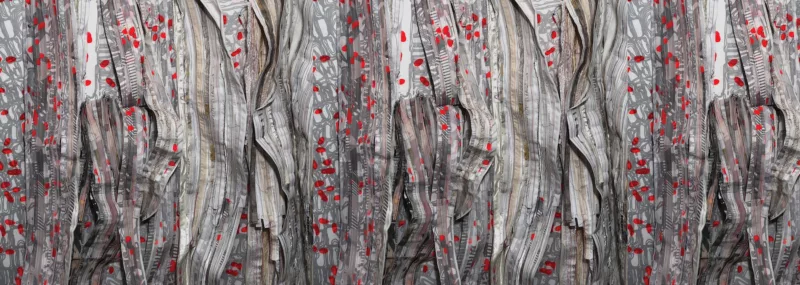
Susan: So, when you do these series do they have elements that can also act as individual works apart from the installation?
Margery: I create individual works—elaborate entities that add up to become characters in my plays; however, in earlier times, I did not view these individual components as objects of art. I was not able to validate them outside of their intended context. It is a paradox when I said “I build intimate relationships with inanimate objects” that I couldn’t see their value relative to dollars. In hindsight, I may have been rewarded more financially as well as built a more significant audience had I recognized their significance and value. Currently, even though most of the pieces in my studio are not residing within the context of an installation, I view them as participating in dress rehearsals—components that teach me the lessons I will need to know when the show opens. Today, would I let them go? Yes indeed. They do carry meaning as individual works of art. Yet their presence amplifies when exhibited as an entire group.
Susan: Describe your current process and materials.
Margery: I employ low-tech, labor-intensive methods of working, creating garment-like forms that speak to the divide between public and personal identity. The sewing machine, my current tool of choice, has become a drawing vehicle and means of attaching layers of fabric. By increasing and decreasing the machine’s tensions, threads react to become glitches. Upon closer inspection what may initially be seen as blemishes are embellishments and details collaborating, creating highly complex and ornate surfaces that are primarily abstract. I repeat the above to create iterations, symbolic of what happens with the passing of familial, cultural, and global trends, from one generation to the next.
The gallery walls transform from sterile white surfaces to a space where they are covered and layered with highly patterned digitally printed oversized mural material. In essence, these imaginary typographies make the walls like second skins, as does clothing for our bodies. Sections of what appear as wallpaper can be unzipped, temporarily becoming parts of what seem to be wearable garments. Covered with meandering zippers and hidden magnets, these modular components can be detached and moved providing new views.
What we inherit cannot be changed, yet if we pay attention to the gifts from the past rather than the burdens, we can find the means to create new perspectives. Working with my hands enables me to think outside of language. This has become my vehicle for digesting, reconfiguring, and integrating some of life’s complexities. It is as if at times my brains are in my hands!
I also like to reference my Jewish heritage and familial connections to the garment industry with the idea of the schemata, a ragged and tattered garment. My sewing process, glitches, and all, are revealed on both sides of what at times becomes a garment. This turns what could be considered high fashion/art into looking like old, ragged apparel, a tattered article of clothing.
Susan: Describe your most recent body of work. What are you working on now?
Margery: I’ve been influenced for over twenty years by Charlotte Perkins Gilman’s fictional short story, “The Yellow Wall-Paper.” A particular passage has carried meaning; “There are things in that wallpaper that nobody knows but me or ever will. Behind that outside pattern the dim shapes get clearer every day.”
The story takes place in Victorian times. The main character, Jane, who is married to a doctor, has recently given birth to their child, yet she is not responding well to her newborn. Most likely this is what we refer to today as postpartum depression. Her husband thought that she needed bed rest. He took her, their nurse, and their baby, to their summer home. When they arrived, he took his wife to an isolated attic room. Her only contact with the outside world was through a small window. Jane kept a journal until her husband took it away, believing that she needed complete bedrest. As a result, she began hallucinating, seeing moving bodies behind the highly aged yellow wallpaper. She wanted to become one of them and tried to get behind the walls but couldn’t.
The story is dark. Isolation is dark. We as artists who remain studio practitioners also spend many hours isolated in our studios. I, like Jane, ask my works to talk to me. I ask my students if their work is talking. When these inanimate objects talk, this is a signal to listen. Something is resonating deep within. It is also the time to loosen the reigns and trust.
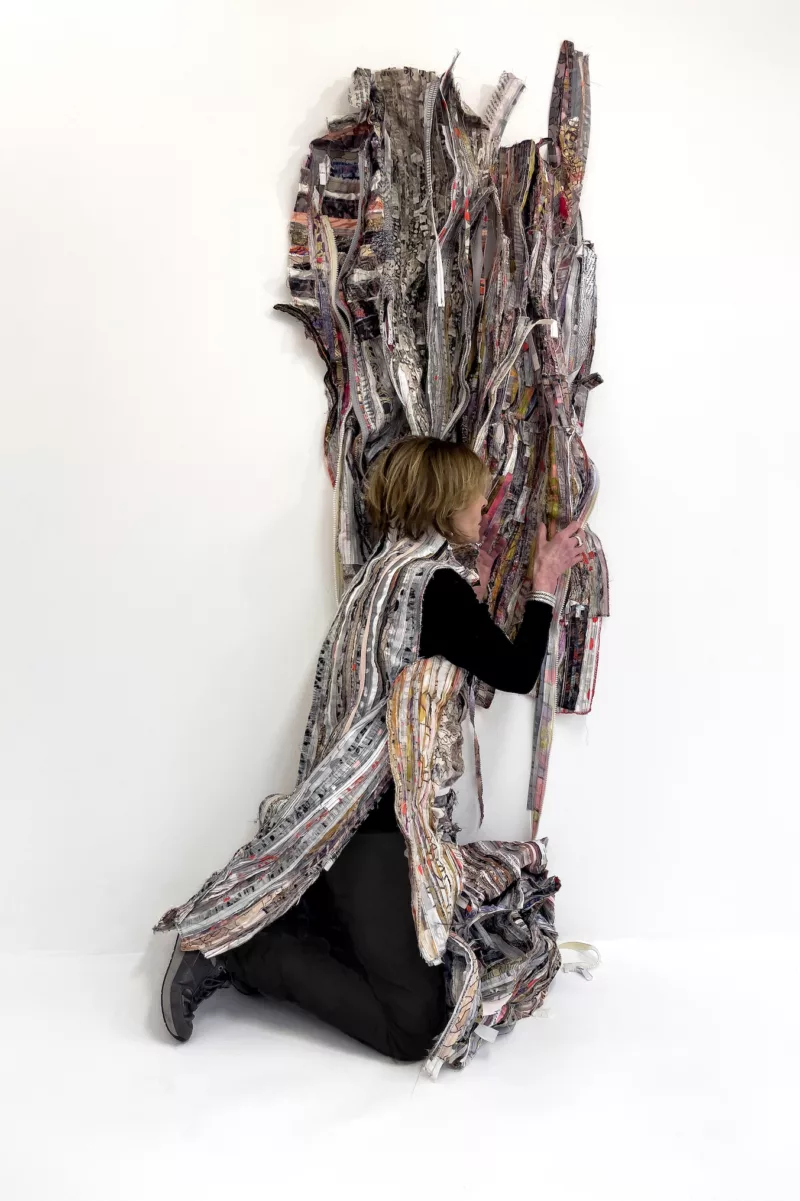
For more than a year and a half, I have been developing a multi-pronged installation that will contain a three-month community-based participatory collaboration to take place in the Stedman Gallery, Rutgers-Camden Center for the Arts. This idea was first proposed one evening, when Cyril Reade, the director of the RCCA, was visiting my studio. We both got extremely excited about the gallery becoming a “living organism,” an oversized work-in-progress. The gallery will be converted into a personal studio space. Extensions of my initial installation will evolve collaboratively. What is created will be integrated into the exhibition. What was once experienced as my voice will, over time, become the voice of many.
We will be extending invitations to community members and students to participate in the conversation. Rutgers faculty will offer workshops on the themes of lineage, identity, and legacy—its gifts and burdens. Sewing machines will be spread throughout the gallery. Their sounds will abound. We will provide patterns, assorted materials, and the opportunity to work in a variety of ways. As gestures of gratitude, the participants will receive a small relic to take home.
My vision is that this installation and the concept itself will move to other venues. When this curtain closes, what was created will remain a work-in-progress. Each time it travels it will carry its past into the next collaboration.
Susan: I look forward to visiting this installation!
[Ed. Note: Judy Pfaff – mentioned by Amdur as a big influence – was covered on Artblog in 2015 when she was in a 3-person exhibit at the Barnes Foundation, along with Fred Wilson and Mark Dion. Read Roberta’s review here.]
More Artblog coverage of Margery Amdur
Roberta’s review from 2012 of a Margery Amdur public art piece at Septa’s Spring Garden Station
Alison McMenamin’s review of “Amass” at Projects Gallery, also from 2012
Full list of Margery Amdur’s exhibits and events this Fall and Winter
The Unbearable Lightness of the Fantastical and Unwearable Art Show at the Drawing Room Gallery, Jersey City, NJ through November 11
Fiber Reimagined, an exhibition in collaboration with Fiber Art Now Magazine, October 6 – November 12, 2023, at the Gravers Lane Gallery, Philadelphia.
Fibre Art Take Two’ s featured artist on October 27th with an hour-long live interview.
World of Threads festival in Ontario, Canada, 2023, (She was awarded a solo show as well as being included in the large group exhibition) October 10—December 17, 2023.
Threads of Continuity, Stedman Gallery, Rutgers University, Camden, beginning January 20, 2024.
(Re)FOCUS, JAN. 27, 2024. She has been invited to participate in The ArtFront Partnership (TAP)’s (Re)FOCUS, celebrating the 50th Anniversary of the original FOCUS, one of the major milestone exhibitions in the history of American women artists, held in Philadelphia in 1974. This citywide project begins with an exhibition and reception at Moore College of Art and Design, January 27, 2024. As a part of that, in February, Amdur and three other women artists will create storefront installations in Old City, Philadelphia.


